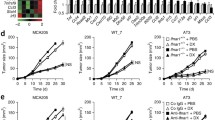Abstract
In continuation of studies on antitumor activities of pyrimidinone interferon inducers [11], we report here that 2-amino-5-bromo-6-mF-phenyl-4(3H)-pyrimidinone (ABmFPP) is similarly effective to 2-amino-5-bromo-6-phenyl-4-pyrimidinone (ABPP) in its ability to reduce the number of metastatic nodules of a spontaneous fibrosarcoma (NFSa) and a spontaneous mammary carcinoma (MCa-K) in the lungs of C3Hf/Kam mice. Both compounds were more effective when given to mice prior to, rather than after, intravenous transplantation of tumor cells. In studies on the mechanism of the antitumor activity of pyrimidinones, 2-amino-5-iodo-6-phenyl-4-pyrimidinone (AIPP) was used in addition to ABPP and ABmFPP. These agents were capable of activating peritoneal macrophages that thus became capable of lysingin vitro 3T12 transformed cells but not syngeneic BALB/c embryo fibroblasts. Also, these agents were capable of augmenting significantly the natural killer (NK) cell activity in the spleen of C3Hf/Kam mice. Spleen cells from treated mice admixed to NFSa cells inhibitedin vivo tumor take of these cells when the admixture was injected subcutaneously. Pyrimidinones were also effective against the development of NFSa nodules in the lungs of T-cell deficient mice implying that the presence of T-cells is not a prerequisite for the induction of antitumor activity by these agents. A further observation was that pyrimidinone compounds reduced the metastasis formation enhancing effect of cyclophosphamide. Therefore, pyrimidinone interferon inducers exhibit an appreciable antimetastatic activity mediated through antitumor resistance mechanisms involving activation of macrophages and stimulation of NK-cells.
Similar content being viewed by others
References
Ando, K., Hunter, N., andPeters, L. J., 1979, Immunologically nonspecific enhancement of artificial lung metastases in tumor-bearing mice.Cancer Immunology and Immunotherapy,6, 151–156.
Baldwin, R. W., andPimm, M. V., 1978, BCG in tumor immunotherapy.Advances in Cancer Research,28, 91–147.
Djeu, J. Y., Heinbaugh, J. A., Vieira, W. D., Holden, H. T., andHerberman, R. B., 1979, The effect of immunopharmacological agents on mouse natural cell-mediated cytotoxicity and on its augmentation by Poly I:C.Immunopharmacology,1, 231–244.
Hanna, N., andFidler, I. J., 1980, Role of natural killer cells in the destruction of circulating tumor emboli.Journal of the National Cancer Institute,65, 801–809.
Herberman, R. B., andHolden, H. T., 1978, Natural cell-mediated immunity.Advances in Cancer Research,27, 305–330.
Herberman, R., Ortaldo, J., andBonnard, G., 1979, Augmentation by interferon of human natural and antibody-dependent cell-mediated cytotoxicity.Nature, London,277, 221–223.
Lotzová, E., andSavary, C. A., 1977, Possible involvement of natural killer cells in bone marrow graft rejection.Biomedicine,27, 341–344.
Lotzová, E., Savary, C. A., Hersh, E. M., Khan, A. A., andStringfellow, D. A., 1981, Potentiation of murine natural killer cell-mediated tumor killing by antiviral pyrimidinone molecules.Proceedings of the American Association for Cancer Research,22, 279.
Lotzova, E., Savary, C. A., andStringfellow, D., 1983, 5-halo-6-phenyl pyrimidinones: New molecules with cancer therapeutic potential and interferon-inducing capacity are strong inducers of natural killer cells.Journal of Immunology,130, 965–969.
Lotzová, E., Savary, C. A., andStringfellow, D. A., 1982, Modulation of murine NK cell cytotoxicity in vitro and antitumor activity in vivo by low molecular weight interferon inducers.Proceedings of Cancer: Etiology and Prevention, edited by R. G. Crispen (in the press).
Milas, L., Hersh, E. M., Stringfellow, D. A., andHunter, N., 1982, Studies on the antitumor activities of pyrimidinone-interferon inducers. 1. Effect against artificial and spontaneous lung metastases of murine tumors.Journal of the National Cancer Institute,68, 139–145.
Milas, L., Hunter, N., Basic, I., Mason, K., Grdina, D. J., andWithers, H. R., 1975, Nonspecific immunotherapy of murine solid tumors withCorynebacterium granulosum.Journal of the National Cancer Institute,54, 895–902.
Milas, L., Hunter, N., Mason, K., andWithers, H. R., 1974, Immunological resistance to pulmonary metastases in C3Hf/Bu mice bearing syngeneic fibrosarcoma of different sizes.Cancer Research,34, 61–71.
Milas, L., Malenica, B., andAllegretti, N., 1979, Enhancement of artificial lung metastases in mice caused by cyclophosphamide. 1. Participation of impairment of host antitumor resistance.Cancer Immunology and Immunotherapy,6, 191–196.
Milas, L., andScott, M. T., 1978, Antitumor activity ofCorynebacterium parvum.Advances in Cancer Research,26, 257–306.
Peters, L. J., McBride, W. H., Mason, K. A., Hunter, N., Basic, I., andMilas, L., 1977,In vivo transfer of antitumor activity by peritoneal exudate cells from mice treated withCorynebacterium parvum: Reduced effect in irradiated recipients.Journal of the National Cancer Institute,59, 881–887.
Peters, L. J., McBride, W. H., Mason, K. A., andMilas, L., 1978, A role for T lymphocytes in tumor inhibition and enhancement caused by systemic administration ofCorynebacterium parvum.Journal of the Reticuloendothelial Society,24, 9–17.
Peters, L. J., andMason, K. A., 1977, Enhancement of artificial lung metastases by cyclophosphamide: Pharmacological and mechanistic considerations.Cancer Invasion and Metastasis: Biologic Mechanisms and Therapy, edited by S. B. Day, W. P. Laird Myers, P. Stansly, S. Garattini and M. G. Lewis (New York: Raven Press), pp. 397–410.
Regelson, W., 1978, Future directions of synthetic polyanions (pyran copolymer).Cancer Treatment Reports,62, 1853–1856.
Stringfellow, D. A., 1980, 6-aryl pyrimidinones: Interferon inducers-immunodulators-antiviral and antineoplastic agents.Augmenting Agents in Cancer Therapy, edited by E. Hersh and M. Chirigos (New York: Raven Press), pp. 215–229.
Stringfellow, D. A., Van Derberg, H. C., andWeed, S. D., 1980, Interferon induction by 5-halo-6-phenyl pyrimidinone.Journal of Interferon Research,1, 1–14.
Van Putten, L. M., Kram, L. K. J., Van Dierenderick, H. H. C., Smink, T., andFuzy, M., 1975, Enhancement of drugs of metastatic lung nodule formation after intravenous tumor cell injection.International Journal of Cancer,15, 588–595.
Author information
Authors and Affiliations
Rights and permissions
About this article
Cite this article
Milas, L., Hunter, N., Ito, H. et al. Studies on the antitumor activities of pyrimidinone-interferon inducers. Part 2 Potentiation of antitumor resistance mechanisms. Clin Exp Metast 1, 213–222 (1983). https://doi.org/10.1007/BF00736405
Issue Date:
DOI: https://doi.org/10.1007/BF00736405




